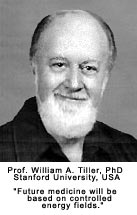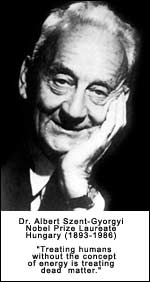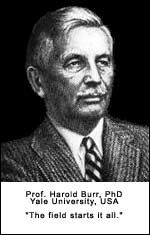Objectives of the FCT® Curriculum
ACKNOWLEDGEMENTS
 My special thanks
My special thanks
to Professor Emeritus W.A. Tiller for his invaluable guidance.
The concepts presented in the curriculum reflected on this
website are related to the fundamental energetic bio-regulation
of homeostasis in humans, and are based on the pioneering work
of the following scientists, among others:
A. Gurwitsch, MD (Russia)
Engineer G. Lakhovsky (France)
Prof. H. Frölich (Germany)
Dr. F. A. Popp (Germany)
Dr. E. Del Guidice (Italy)
B. Nördenstrom, MD (Sweden)
Dr. C. Smith (Great Britain)
Prof. H. Burr (Yale University, USA)
G. W. Crile, MD (Cleveland Clinic Founder, USA)
R. Becker, MD (SUNY at Syracuse, USA)
Dr. R. Adey (Loma Linda University, USA)
Prof. W. A. Tiller (Stanford University, USA)
Savely Yurkovsky, MD
President
The Objectives of the FCT® Curriculum are:

I. To examine current models for practice of medicine – their flaws, benefits and limitations.
II. To introduce new model – the one that is based on the interface of physics and biology, proposed by Professor William A. Tiller of Stanford University.
To present:
1. The human organism as a complex cybernetic open field-system
2. Concept of atomic biology as one of the dual state of matter and energy
3. Homeostasis as field-operated phenomenon
4. Concept of Energy in health and life sustainment
5. Concepts of cellular fields, information and memory. The most fundamental physiological domains in Man. Scientific data from quantum physics and biology.
6. Concept of disease as a state of energetic incoherence and as a strictly individual pathological field-state versus general nosological entity.
III. To discuss major flaws of the contemporary bio-medical research.
IV. To present the main pernicious factors that distort cellular fields.
1. Toxicological
2. Biological
3. Environmental: electromagnetic, geomagnetic, pollutants, etc.
4. Psychological
5. Nutritional
6. Physical: traumas, injuries, dental
7. Emotional
8. Medicinal
9. Genetic
10. Others

V. Their identification.
Examination and critical analysis of modern diagnostic methods, conventional and alternative. Their benefits and limitations.
VI. Their removal or modification.
Examination and critical analysis of modern therapeutic methods, conventional and alternative. Their benefits and limitations.
VII. To illustrate stages of disease progression according to energetic and cellular tissue degeneration. Their general correlation with the accepted nosological entities.
VIII. To define scientific principles for the practice of Integrative Medicine.
1. To acquaint practitioners with the clinically relevant concepts of medical toxicology, immunology, endocrinology and infectious diseases. The clinical importance of their dynamic interrelationships.
2. Homeopathic management of toxicological and infectious problems. Why avoidance of the routine use of antibiotics and other pharmaceutical anti-microbial agents is a scientific reality.
3. Appreciation of proper sequence and course of therapy aimed at detoxification, restoration, and raising energy reserve.
4. The most efficient principles of therapy-combining based on the understanding of their benefits, limitations, the corresponding stages of cellular organ-tissue damage and available energy reserve; proper choices and timing.
5. Achieving maximum benefits while avoiding therapeutic conflicts and high costs.
IX. Discussion of the concept of a difficult patient. Major blocks in cure and means to overcome them.
X. To outline the most effective program in prevention of degenerative diseases.
XI. To present FCT® diagnostic-therapeutic system, its unsurpassed clinical superiority, efficacy and cost containment. Doctor-patient teamwork.
